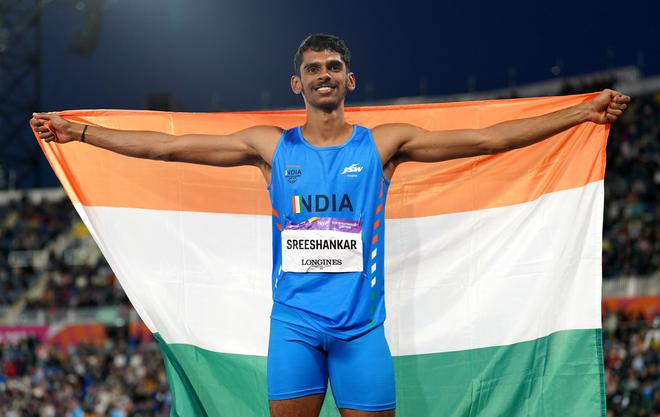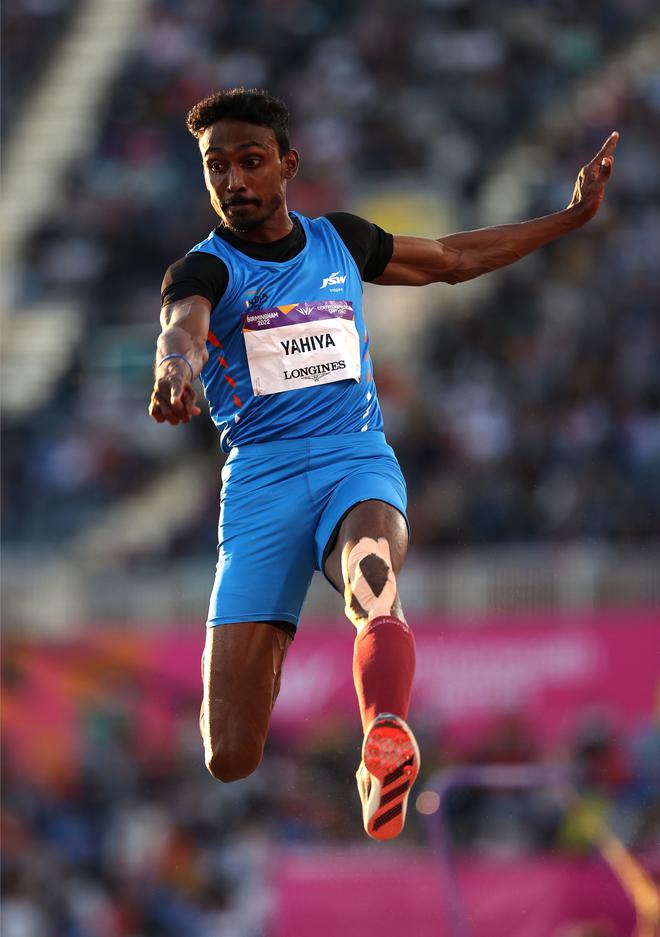

Around this time last year, M. Sreeshankar and his dad S. Murali were down, dejected and very lonely. Suffering from muscle imbalance issues, long jumper Sreeshankar had failed to qualify for the final at the Tokyo Olympics. His nightmare began there.
With the youngster’s performance slipping from the National record high of 8.26m at the Federation Cup in Patiala in March 2021 to 7.74m three months later, the Athletics Federation of India (AFI) had told Murali — also his son’s coach — to give an assurance that Sreeshankar would reproduce the qualification standard in Tokyo and that he would take full responsibility for it.
When Sreeshankar’s performance fell further in Tokyo (7.69m), the AFI was quick to ‘sack’ Murali. It said his coaching was unscientific.
But those hard days taught Sreeshankar and his dad some very crucial lessons. It brought the father and son a lot closer, and the youngster became mentally stronger too.
He continued training with his dad near his home in Palakkad and resolved to return to the national camp only after crossing 8.30m. Sreeshankar kept his word and produced a massive 8.36m, which broke his own National record, at the Federation Cup at Malappuram in April. And suddenly, life changed.
World class
That jump carried him to the No. 2 spot in this year’s world list, a rung he now shares with Greece’s Olympic champion Miltiadis Tentoglou and China’s World champion Jianan Wang.
Sreeshankar also qualified for the final at the World Championships, the first Indian to do so, and finished seventh. And recently in Birmingham, he became the first Indian to win the men’s long jump silver at the Commonwealth Games with 8.08m, a distance achieved by the gold medallist too.
“Tokyo was certainly on my mind,” said Sreeshankar after his Birmingham silver, his first major medal.
“I’ve had a lot of setbacks previously also. In Oregon [recent Worlds], as well as in Belgrade [Indoor Worlds in March], I was seventh. I just wanted to get onto the podium, to get a fresh start. I’m happy that I was able to get it.”
Sreeshankar’s star is rising and Murali’s is too.
With no coach being sent with the three triple jumpers and the lone high jumper, Tejaswin Shankar, Murali was seen guiding them at the Commonwealth Games. Waving his hands and pointing here and there from the stands, he appeared like the conductor of an orchestra as he offered crucial tips during the finals.
And the results were excellent. The Indian athletics team finished with eight medals and four of them, including the lone gold, came from the jumpers, with triple jumpers Eldhose Paul and Abdulla Aboobacker providing the country’s first-ever gold-silver show while high jumper Shankar won a bronze.
Missing out
Like the triple jump, the long jump also saw three Indian men qualifying for the Worlds. All three should have been in Birmingham, but the AFI stopped India No. 2 Jeswin Aldrin (personal best 8.26m) from going to the Commonwealth Games as he could not repeat the big jumps, made earlier in the Malappuram Federation Cup, at the Inter-State Nationals in Chennai, the federation’s main qualifier.
It is now very clear that long jump in India is in its best phase ever. Ample proof of that is the very consistent Muhammed Anees who finished fifth in Birmingham with 7.97m to add to Sreeshankar’s silver. One wonders what the scene would have been had Aldrin travelled to the Commonwealth Games as well.
Incidentally, Aldrin — according to sources in JSW Sports, which supports and trains him at the Inspire Institute of Sports at Ballari — has been working on his speed and trying to get faster, so there is a control issue and that could have been the reason for the many fouls that pulled him down in recent competitions.
For years, Anju Bobby George has been saying that the horizontal jumps, especially the long jump, offered the best potential for India to win medals at the majors.
Anju had also shown the way with her 2003 Paris Worlds bronze — Olympic champion Neeraj Chopra, who won the javelin throw silver recently in Oregon, is India’s only other World Championships medallist — and now that she is a senior vice-president in the AFI, the jumps have somebody talking for them in the meetings that matter.
Fighting for medals
“Am really happy that the horizontal jumps are doing very well, even in international competitions they are reproducing their best. And now, we have a young bunch of athletes in the long and triple jumps. And Sreeshankar has the best potential and chances of doing well at the majors,” said the former Asian Games champion, also the country’s first woman to win a Commonwealth Games medal in athletics (bronze, Manchester 2002).
“Earlier, our athletes just went, showed their faces and returned from the majors. Now, they have started performing and fighting with the world. The fear factor has gone from our athletes, the mental block is no longer there. Even if we are not winning medals, we are actually fighting. And after the Olympic gold, we got a Worlds silver [Chopra].”
So what could be the reason for this new confidence?
“Now, the world is open to everybody, nobody can hide anything. Our athletes can watch videos of the top stars, watch them perform in big stadiums at the majors, that way they also sort of get close to the competitions. And they can see the celebrations at home when medals are won. That keeps motivating athletes,” said Anju.
Getting comfortable
Not just that, getting into the circuit helps athletes feel at home while competing with the big stars.
‘Braaaaavoo,’ was Tentoglou’s coach Georgi Pomashki’s first word when he met Sreeshankar in Monaco during the Diamond League.
“We are competing with the best guys here, we need that. The more we get [such meets], the better we will be,” said Sreeshankar from Monaco.
Anju fully agrees with that.
“They need more competition exposure. But they should have a base in Europe or America where they can train for one or two months. It should be a training-cum-competition trip,” said Anju, still the National record holder.
“The athletes and coaches should together plan their preparations. We can’t always look up to the AFI, it is not the federation’s job to find competitions for athletes.
“Athletes and coaches have to decide on their training venues and competitions according to their priorities. They have to decide which competition they are getting ready for and how their preparations should be. It is their duty to make a calendar and then approach the AFI and the ministry to get it approved.”
Opportunities needed
With athletes getting bolder and producing results in the long jump, one of the priority events for the AFI, the federation should also ensure that they get more opportunities to compete at the majors. There is no point in forcing an athlete to repeat a qualifying performance in meets held just before the majors.
Wang’s performance at the recent Worlds should offer some valuable lessons. The Chinese long jumper competed in just one event, where he jumped 7.67m, prior to the Oregon Worlds. But he came up with a last round of 8.36m to shock Tentoglou and grab the gold.
Who knows, there could be somebody like that in India too.







